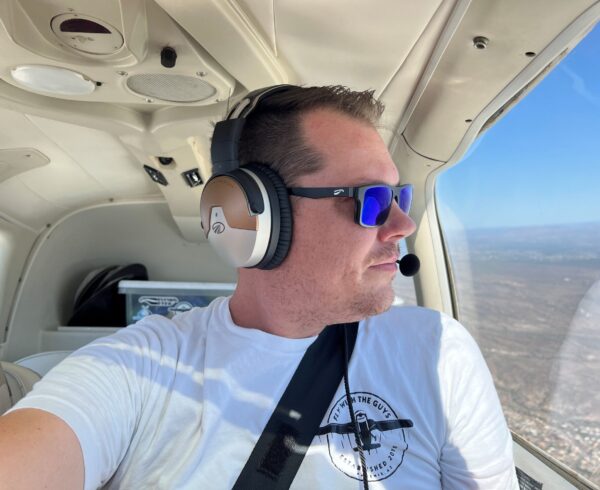Aviation Survival Kit – Noah Alexander
Recently Lightspeed Aviation hosted a Survival Gear Contest, asking to see pilot’s aviation survival preparedness kit and had each submission scored by our panel of Celebrity Judges with extensive experience, background, and knowledge in survival and survival preparedness. With numerous well-thought entries, our panel had their work cut out for them! Please join us in congratulating our Third Place Winner: Noah Alexander. Enjoy Noah’s submission below.
Judges gave high praise for his personal floatation device vest and speaking towards the topic of training. Judges remarked, “A well-considered approach!” and “A top contender!”
This document aims to effectively demonstrate my aviation survival gear load out. Within this blog, three photo swill be included: the on-body equipment picture, the flight bag equipment picture, and the required equipment picture. In each picture, the equipment will be displayed in an exploded-view format and labeled with a red number that corresponds with the explanation number found in this document. Before the explanation section for each photo, I will address the location of the equipment in the aircraft. For each component in each picture, I will explain he purpose of the equipment in a post-crash situation. Additionally, I will mention the tool that I feel is the most important piece of survival equipment for every pilot to carry, and also address some additional preparations that can be made beyond carrying equipment to increase chances of survival in the event of a crash. Thank you for your consideration in this contest and also for encouraging the aviation community to be as safe as possible.
On-Body Equipment

#1 Stearns float coat– an effective PFD after ditching the aircraft for a swimmer that is conscious while also providing ample storage solutions for survival equipment. It allows for automatic inflation via a CO2 cartridge as well as oral inflation through the red tube on the left side (pictured).
#2 See-Me strobe light– waterproof 45 lumen strobe light that can be seen by rescuers searching for occupants of a crashed aircraft for up to three miles during nighttime. The light can be manually activated by the user or is automatically activated in water.
#3 Phone holder with a lanyard attachment– attaches a cell phone to the vest to reduce the risk of loss during a crash so that the phone can be used to contact rescuers.
#4 Leather man Signal- multitool with increased emphasis on tools that would aid in building a fire and shelter, or in signaling rescuers in a post-crash situation.
#5 USB Rechargeable Headlamp– primary light source to aide in conducting post-crash activities such as evaluating the health of passengers or building a fire/shelter.
#6 2-Person First Aid Kit– includes all standard items found in a first aid kit needed to treat basic first aid problems that could be created during a crash. It is also waterproof.
#7 Bic Lighter– standard lighter that acts as an easy fire starter in a survival situation.
#8 Leather Belt Pouch– holds: a Garmin inReach Mini, a Bic lighter, and a preflight flashlight (not pictured) to serve as a more secure place to keep essential items that would be needed after a crash.
#9 Garmin inReach Mini– personal GPS location device for contacting rescuers in the event of a crash. It is also water submersible and shock resistant.
#10/11/12 UST Sparkie fire starter and Wetfire tinder combined in a waterproof Pelican case to serve as a secondary method for starting a fire in a survival situation.
#13 SOL Bivy Sack– a highly compressible shelter that can be set up quickly or supplement a more refined emergency shelter to protect aircraft occupants from the elements after a crash. #14 LifeStraw- a portable water purifying filter that eliminates the need to build a fire for safe water consumption.
#15 Sabercut– a portable chainsaw that can be used for gathering large branches for building an emergency fire or shelter.
#16 Leatherman Raptor– high-strength shears that can be used for: removing clothing quickly to administer medical treatment, salvaging robust material from the crashed aircraft, or breaking glass with the glass-breaking bit.
#17 Datrex Ration Bars– emergency food source for post-crash consumption that has a shelf life of five years.
Flight Bag Equipment

#1 PJ2 COM Radio– Battery or USB powered handheld radio that supports conventional operation as well as operation with an aviation headset through dual GA plugs. Despite the limited range of this device, it could be an invaluable resource in the event of a crash should the pilot be able to establish communications on an area frequency with rescuers.
#2 Portable Battery– portable charging device that could provide power to a multitude of devices in a survival situation such as a phone, a light, or a handheld radio.
#3 Tissues– Auxiliary clotting device for administering medical treatment alongside first aid kits or a tinder device for starting a fire.
#4 Flint and Steel Kit- small bag containing a flint and steel to provide another fire-starting tool in the event of a crash where other fire-starting equipment could not be recovered. It is used instead of a second lighter to eliminate the presence of combustible fuel within the flight bag.
#5 Compressible Water Flask– provides a way to transport water for consumption in a post- crash situation in the event that another container could not be recovered from the aircraft.
#6 Knife Sharpener– primarily carried in conjunction with the required equipment kit discussed below as it can aide in the use of the other survival tools such as a hatchet, or fishing equipment.
#7 Single-Wall Stainless Steel Bottle– in a post-crash situation, it would primarily be used for the purification of water by placing it in a campfire to boil the water.
#8 USB Rechargeable Flashlight– an additional light source that can used in a variety of ways in a survival situation such as signaling or completing tasks in the dark.
#9 Battery Powered Headlamp– provides redundancy for the USB rechargeable headlamp and accomplishes survival uses of a light source.
#10 Battery Powered Flashlights– provides a light source for occupants that may not have carried one on the flight and provides redundancy for the USB rechargeable flashlight and accomplishes survival uses of a light source.
Required Equipment

#1 Snow Shoes– used to more efficiently traverse a snow-covered environment post-crash.
#2 Sleeping Bag– used as an emergency source of shelter in a freezing environment to increase chances of survival.
#3 Mosquito Head Nets– used to prevent occupants of the aircraft from being afflicted with copious amounts of mosquito bites in a post-crash situation.
#4 Signaling Flares– provides a means of signaling rescuers in a post-crash situation.
#5 Emergency Survival Blanket– similar to the Bivy Sack shown above, it provides a source of shelter for aircraft occupants in a post-crash situation.
#6 Waterproof Matches– provides an additional tool for making a fire in a survival situation.
#7 Datrex Ration Bars– emergency food source with a shelf life of five years.
#8 Fishing Kit- supplies of line and hooks to aide in obtaining food in a survival situation.
#9 Hatchet and Fixed Blade Knife– tools to help complete the numerous tasks required to survive in a post-crash situation such as making a fire or shelter.
#10 Class A First Aid Kit– contains more resources for treating medical emergencies that are created by a post-crash situation than the first aid kit carried on-body.
I think the single most important post-crash tool that every pilot should be carrying is a waterproof tool for starting a fire. It could be matches, a ferro-cerium rod, or a lighter, but it should be something that the pilot is competent in operating. I feel this is the most important thing for a pilot to carry because it is unlikely that drinking tainted water will cause a person significant harm before rescuers can recover them, and because it is likely that the crashed aircraft will have a functional ELT.
Aside from carrying equipment, additional preparedness steps to take that could increase the chances of surviving a crash include: filing a flight plan for every flight, completing refresher training with a CFI that includes simulation of different crash scenarios, and undertaking other types of training that could aide in post-crash situations such as EMT or wilderness survival training.















I most likely utilize my gourmet specialist’s blades more than some other apparatus in the kitchen. I’m not hitched to a specific brand, since they all work, they all have sharp cutting edges.
Very complete. Thanks for the great ideas.
For seaplane water upsets (and possibly ditching a land plane) the aircraft may be partially or fully inverted. Seaplane pilots and occupants typically use only manual inflatable PFD’s, or disable the automatic feature, to avoid being trapped inside the cabin as water rises. We are trained to exit the aircraft , then inflate the PFD.
I fly float planes and always wear my inflatable suspender or vest type life jacket.